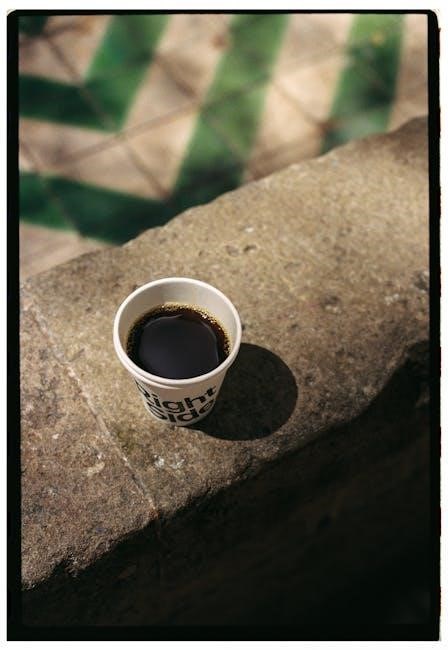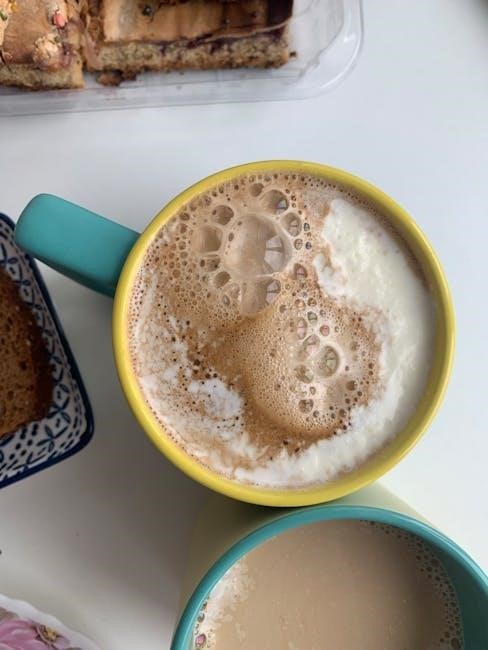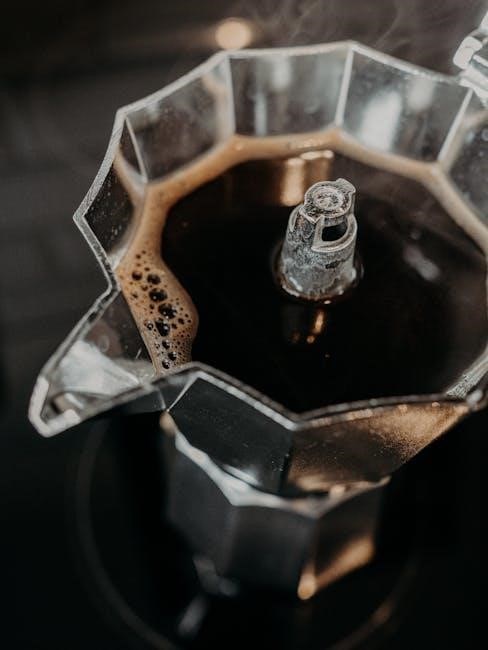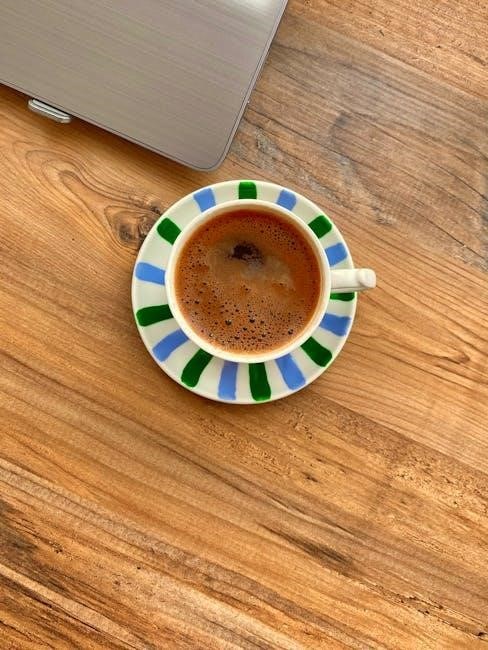Espresso is the foundation of specialty coffee, known for its rich flavor and velvety texture. A concentrated coffee beverage, it’s cherished for its bold taste and aromatic depth, serving as the base for beloved drinks like lattes and cappuccinos.

What is Espresso?
Espresso is a concentrated coffee beverage made by forcing pressurized hot water through finely ground coffee beans. It is characterized by its thick, creamy texture, known as crema, and its bold, rich flavor. Unlike drip coffee, espresso is served in small quantities, typically 1-2 ounces, and is often enjoyed on its own or as the base for popular drinks like lattes and cappuccinos. The unique brewing process involves high pressure, which extracts the coffee’s oils and solids, resulting in a distinctive taste and aroma. Espresso beans are usually roasted darker than regular coffee to enhance their intensity and depth, making it a favorite among coffee enthusiasts worldwide.

History and Origins of Espresso
Espresso has its roots in late 19th-century Italy, where Angelo Moriondo first patented a device to make concentrated coffee in 1884; Luigi Bezzera improved this concept, creating a machine that forced pressurized hot water through coffee grounds, laying the groundwork for modern espresso. Desiderio Pavoni further refined Bezzera’s design, introducing the first commercial espresso machine at the 1906 World’s Fair in Milan. The name “espresso” reflects the on-demand nature of the brewing process. By the mid-20th century, espresso had become a cornerstone of Italian culture, with iconic machines like the Gaggia and Faema revolutionizing its preparation. Today, espresso remains deeply tied to its Italian heritage, symbolizing tradition, innovation, and the art of coffee-making.
Key Characteristics of a Perfect Espresso
A perfect espresso is defined by its thick, creamy crema, which should be about 1/4 inch thick and have a rich, reddish-brown color. The flavor profile should be balanced, with notes of sweetness, acidity, and bitterness. A velvety texture and full body are essential, creating a luxurious mouthfeel. The aroma should be intense and inviting, with hints of roasted coffee beans. Temperature is critical, ideally served between 195°F and 205°F to preserve flavor without burning. The volume should be around 1 ounce, pulled in 20-30 seconds, ensuring optimal extraction. Freshness is key; beans should be ground just before brewing to maximize aroma and flavor. These elements combined create the ultimate espresso experience, showcasing the artistry and science of coffee-making.

Essential Equipment for Making Espresso
Essential Equipment for Making Espresso includes a high-quality espresso machine, coffee grinder, tamper, and a portafilter. These tools ensure precise control over the brewing process, delivering optimal flavor.

The Role of an Espresso Machine
An espresso machine is the centerpiece of espresso preparation, responsible for forcing pressurized hot water through finely ground coffee beans. This process extracts the concentrated beverage that defines espresso. The machine ensures precise temperature and pressure control, essential for achieving the optimal flavor and crema. It enables the extraction of the coffee’s unique oils and solids, creating the distinctive taste and texture. With various types available, from manual to automatic, the espresso machine remains a vital tool for both home enthusiasts and professional baristas, delivering the foundation for countless espresso-based drinks.
Importance of a Coffee Grinder
A coffee grinder is essential for achieving the perfect espresso, as it ensures the coffee beans are ground to the ideal consistency for extraction. Freshly grinding the beans just before brewing preserves the coffee’s aromatic compounds and flavor, which are quickly lost in pre-ground coffee. The grind size must be precise to match the espresso machine’s requirements, allowing for even extraction. A burr grinder is preferred over a blade grinder, as it produces a consistent grind without generating heat, which can damage the beans. Investing in a quality grinder is vital for maximizing the flavor and aroma of your espresso, making it a cornerstone of the espresso preparation process.
Other Necessary Accessories
Beyond the espresso machine and grinder, several accessories are crucial for crafting the perfect shot. A tamper ensures even coffee distribution in the portafilter, while demitasses provide the ideal cups for serving. A scale is essential for measuring precise coffee and water ratios, enhancing consistency. Cleaning tools, like group head brushes, maintain machine hygiene and performance. A knock box simplifies disposal of used coffee grounds, keeping the workspace tidy. Lastly, a water filter prevents mineral buildup in the machine, ensuring optimal water quality. These accessories collectively elevate the espresso-making process, contributing to better-tasting shots and machine longevity.

The Espresso Brewing Process
The espresso brewing process involves precise steps to extract rich, concentrated coffee. Tamping ensures even extraction, while the machine forces pressurized hot water through the grounds, yielding a creamy shot.
Step-by-Step Guide to Pulling the Perfect Shot
Pulling the perfect espresso shot requires precision and attention to detail. Start by preheating your espresso machine and portafilter. Grind 14-17 grams of high-quality coffee beans to a fine consistency and distribute evenly in the portafilter. Tamp firmly to ensure a flat surface, applying about 30 pounds of pressure. Attach the portafilter to the machine and place a demitasse cup underneath. Initiate the brewing process, aiming for a 25-30 second extraction. The espresso should flow smoothly, producing 1-2 ounces of rich, creamy liquid. Serve immediately to preserve the aroma and flavor. Practice makes perfect, so experiment with grind size and tamping technique to refine your shots.

Tamping: The Key to Even Extraction

Tamping is a critical step in the espresso-making process, ensuring even extraction and a balanced flavor. Start by placing 14-17 grams of ground coffee in the portafilter. Use your fingers to evenly distribute the grounds, then place the tamper on top. Apply steady, firm pressure (about 30 pounds) in a downward motion, ensuring the surface is flat and level. Proper tamping prevents channeling, where water flows unevenly through the coffee, leading to under-extraction. After tamping, wipe the portafilter rim to remove excess grounds. A well-tamped shot ensures optimal flavor and crema formation. Practice tamping to achieve consistency, as it directly impacts the quality of your espresso.

Popular Espresso-Based Drinks
Espresso forms the base for iconic beverages like lattes, cappuccinos, and macchiatos, each offering unique textures and flavors. These drinks have become staples in global coffee culture.
Latte, Cappuccino, and Macchiato: What’s the Difference?
A latte, cappuccino, and macchiato are beloved espresso-based drinks, each with distinct characteristics. A latte combines 1-2 shots of espresso with steamed milk and a thin layer of foam, offering a milky texture. A cappuccino balances espresso, steamed milk, and a thick layer of foam in equal parts, providing a creamy and rich experience. A macchiato is the simplest, featuring a shot of espresso “marked” with a small dollop of frothed milk. These drinks vary in milk-to-coffee ratios, catering to different preferences. Lattes are milkiest, cappuccinos are balanced, and macchiatos highlight the espresso’s boldness, making them popular choices for coffee lovers worldwide.
Other Creative Espresso-Based Beverages
Beyond the classics, espresso serves as a versatile base for innovative drinks. The Red Eye combines espresso with drip coffee for a bold, energizing twist. Espresso Con Panna features a dollop of whipped cream on top, offering a sweet and creamy contrast. The Marocchino blends espresso, cocoa powder, and steamed milk, creating a chocolatey delight. For something refreshing, the Espresso Tonic mixes espresso with tonic water, garnished with citrus. Another unique option is the Affogato, where a shot of hot espresso is poured over cold vanilla ice cream. These creative beverages showcase espresso’s adaptability, catering to diverse tastes and preferences, whether sweet, refreshing, or rich and decadent.

Advanced Techniques for Espresso Enthusiasts
Advanced techniques include latte art design, experimenting with brewing times, and refining coffee-to-water ratios. These methods require precision and creativity, elevating espresso craftsmanship.
Latte Art and Design
Latte art is the creative process of crafting visually appealing designs on the surface of espresso-based drinks. It combines artistic expression with technical skill, enhancing the coffee experience. Baristas use steamed milk to create intricate patterns like hearts, leaves, and geometric shapes. Achieving flawless latte art requires precise control over milk temperature, texture, and pouring techniques. High-quality milk is essential for smooth microfoam, which is crucial for detailed designs. Advanced baristas often experiment with etching tools and layered pouring methods to create 3D effects. Latte art not only adds aesthetic appeal but also reflects the barista’s mastery and passion for their craft, making each drink unique and Instagram-worthy.
Experimenting with Brewing Times and Ratios
Adjusting brewing times and coffee-to-water ratios allows for personalized espresso experiences. Brewing time impacts extraction, with shorter times yielding brighter, acidic notes and longer times producing bolder, sweeter flavors. Ratios, typically 1:2 to 1:3, influence strength and body. Experimenting with these variables helps tailor the shot to individual preferences. For instance, a ristretto (shorter time) emphasizes intensity, while a lungo (longer time) offers a milder taste. Using a scale and timer ensures precision, enabling consistent results. Enthusiasts can explore ratios like 1:1 for a concentrated shot or 1:4 for a lighter profile. Patience and practice are key to mastering these adjustments, as small changes significantly impact flavor; This experimentation elevates the espresso-making process, making it both an art and a science.
